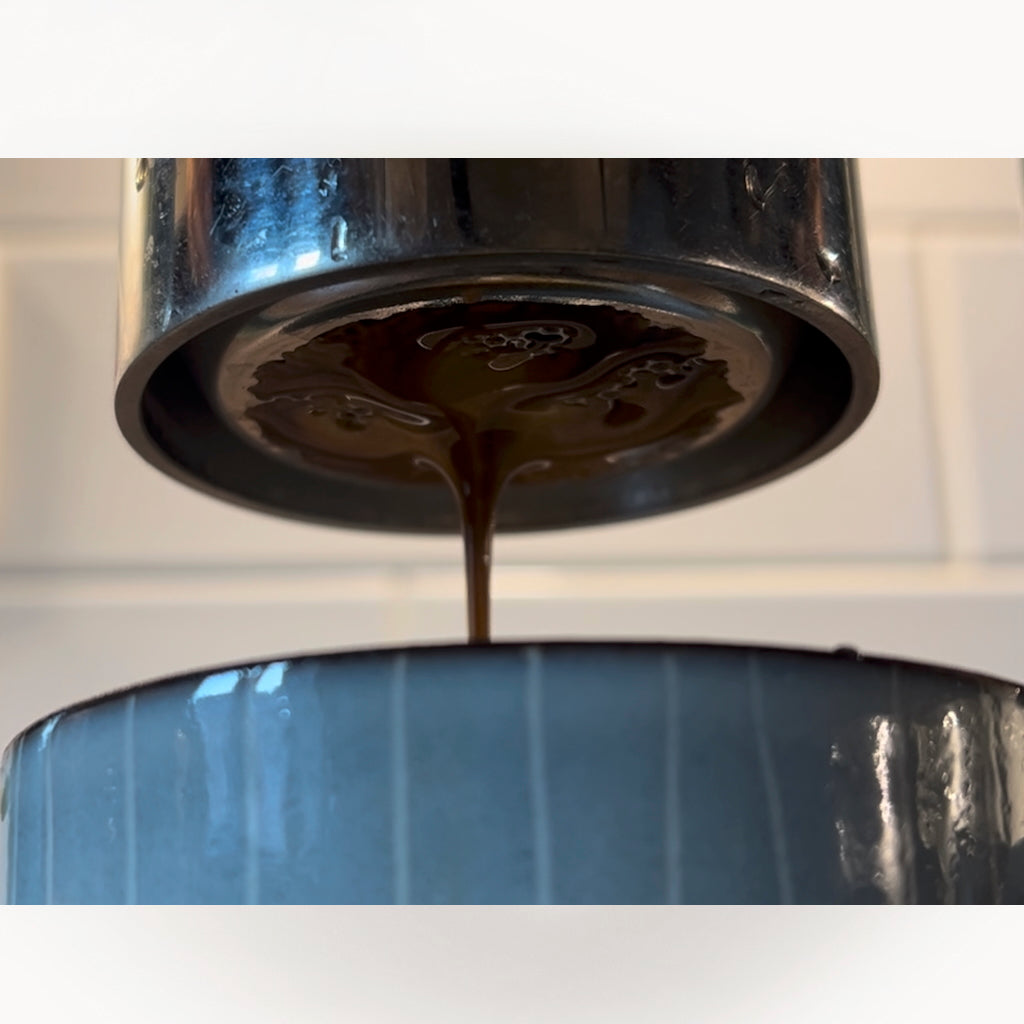Understanding Uneven Channelling with the Cafelat Robot
September 7, 2025 – Kristal Yam

Why it's common, what causes it, and why you probably don’t need to worry
If you’ve ever noticed your espresso shot flowing slightly off-centre or unevenly from your Cafelat Robot when using it without the spouts installed (naked portafilter), do not be overly concerned. This phenomenon, known as uneven channelling, is surprisingly common with any espresso machine, especially when people are starting out in making espresso. The good news? It’s rarely something to worry about, and in most cases, it doesn’t negatively affect the taste of your shot. It is more of a visual thing really.
What is Channelling?
Channelling occurs when water finds paths of least resistance through the coffee puck during extraction. Instead of flowing evenly through the bed of coffee, the water “channels” through weaker spots, leading to an uneven extraction. This can show up as streams of espresso favouring one side of the basket, or flowing more from one area than another.
There are two main types of channelling:
- Uneven channelling: The flow is not quite centred or balanced.
- Severe channelling: Water rushes through visible gaps or cracks, often leading to under-extracted espresso.
What factors that can cause channelling are specific to the Cafelat Robot and other manual lever machines?
On a pump machine the pump provides a constant steady pressure. On a spring lever machine the pressure is steady but gently declines throughout the shot. But the Robot and many other manual lever machines, are completely manual espresso machine, they rely on user-applied pressure throughout the extraction. The user controls the pressure at all times.
The most important point to note is to maintain a steady pressure, do not push, then lift, and then push again. This will undoubtedly ruin the shot.
Common Causes of Uneven Channelling
Here are some common causes of uneven channelling and what you can do to improve consistency:
1. Uneven channelling: The flow is not quite centred or balanced.
2. Tamping Technique: If the coffee bed is not level or tamped unevenly, water will flow through the path of least resistance. Make sure to tamp with even, firm pressure. A tamper that fits snugly helps greatly.
3. Grind Size & Dose:
- Too coarse: Can lead to water passing too easily and creating fast channels.
- Too fine: May cause over-extraction or restrict flow entirely.
Adjust your grind gradually to find the sweet spot for your beans. Aim for a consistent dose, typically around 16-18g for the Cafelat Robot. Under-dosing or over-dosing can affect pressure balance and water flow.
4. Distribution of Coffee Grounds: Clumps in the coffee bed are a major cause of channelling. Before tamping, stir the grounds using a WDT tool (Weiss Distribution Technique), or even a simple paperclip, to break up clumps and create a more even bed.
Should You Be Concerned?
In most cases, no. Uneven channelling with the Cafelat Robot or any espresso machine is a minor aesthetic issue rather than a functional one. Unless you're experiencing severe under-extraction or over-extraction, the quality of the espresso in the cup will still be excellent.
Below is a video when we are testing a return basket following a customer’s concern that the channelling may not be positioned centrally. As the machine was set slightly further back than its normal position while filming, a little more force is applied on the left arm towards the end. After carrying out several checks, we could not identify any issue with the channelling with the basket.
When learning we recommend that if you are experiencing severe channelling that sprays everywhere, install the spouts to control the flow from the basket. When you are more used to tamping and distribution and have got the shot time within the magic 25-35 second window, then remove the spouts and try again with the naked portafilter.
The Cafelat Robot is a beautifully simple yet powerful manual espresso machine. With its deep basket and user-controlled pressure, it's natural for some variance to appear in your extractions, including occasional uneven channelling. As long as your coffee tastes good, there’s no need to worry.
Happy brewing!

